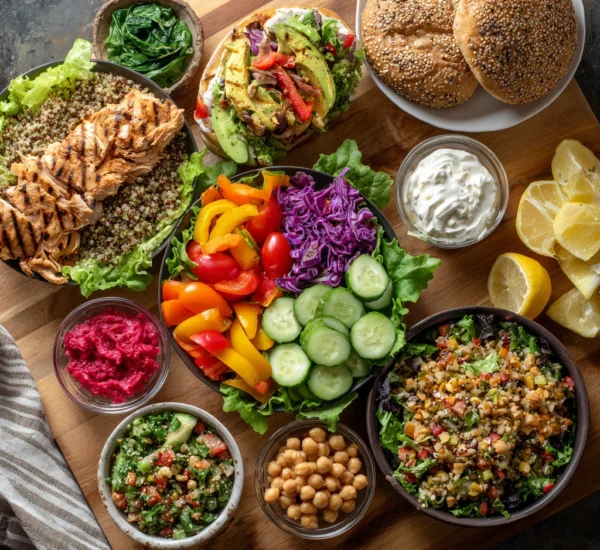How to Balance Flavor and Nutrition: A Complete Guide
Eating healthy doesn’t have to mean sacrificing taste. In fact, the most sustainable and enjoyable approach to a healthy diet is one that balances both flavor and nutrition. This guide will walk you through the principles and practical techniques for creating delicious and nutritious meals that you’ll actually look forward to eating.

Understanding the Interplay of Flavor and Nutrition
The misconception that healthy food is bland is a common barrier to healthy eating. However, flavor and nutrition are not mutually exclusive. Many nutrient-rich foods are naturally packed with flavor, and even those that aren’t can be enhanced with the right techniques.
Nutrient Density: The Foundation of a Balanced Diet
Nutrient density refers to the amount of nutrients a food provides relative to its calorie content. Focusing on nutrient-dense foods like fruits, vegetables, lean proteins, and whole grains is the first step in building a balanced diet. These foods provide essential vitamins, minerals, and antioxidants, contributing to overall health and well-being.
The Role of Flavor Profiles in Healthy Eating
Understanding different flavor profiles – sweet, salty, sour, bitter, and umami – is crucial for creating satisfying meals. By incorporating a variety of flavors, you can stimulate your taste buds and make healthy food more appealing. For example, a salad that includes bitter greens (like arugula), sweet berries, salty cheese, and a tangy vinaigrette will be far more satisfying than a plain lettuce salad.
The Psychological Impact of Flavor
Flavor plays a significant role in our eating habits. Enjoyable flavors can increase satiety, helping us feel fuller and more satisfied, which can aid in weight management. Conversely, bland or unappetizing food can lead to overeating in search of satisfaction. Creating flavorful meals can transform your relationship with healthy eating, making it a sustainable and enjoyable lifestyle.
Mastering Flavor-Boosting Techniques for Nutritious Meals
Once you understand the importance of balancing flavor and nutrition, you can start implementing techniques to enhance the taste of healthy foods. These techniques are simple, effective, and can be easily incorporated into your cooking routine.
Herbs and Spices: Nature's Flavor Enhancers
Herbs and spices are a powerhouse of flavor and antioxidants. They can transform the taste of any dish without adding significant calories or unhealthy fats. Experiment with different combinations to find your favorites.
- Fresh Herbs: Add brightness and freshness to dishes. Examples include basil, cilantro, parsley, mint, and rosemary.
- Dried Spices: Provide depth and warmth. Examples include cumin, coriander, paprika, turmeric, ginger, and cinnamon.
- Spice Blends: Offer convenient and complex flavor profiles. Consider using blends like curry powder, Italian seasoning, or chili powder.
Acidity: Brightening and Balancing Flavors
Adding acidity can brighten up flavors and create balance in your dishes. This can be achieved using ingredients like lemon juice, lime juice, vinegar, or even fermented foods.
- Citrus Juices: Perfect for dressings, marinades, and sauces.
- Vinegars: Balsamic, apple cider, and red wine vinegar add distinct flavors to salads and sauces.
- Fermented Foods: Yogurt, kefir, sauerkraut, and kimchi provide both acidity and probiotics.
Healthy Fats: Adding Richness and Satiety
Healthy fats are essential for overall health and can also enhance the flavor and texture of food. They help carry flavors and increase satiety.
- Olive Oil: Use extra virgin olive oil for dressings and finishing dishes, and regular olive oil for cooking.
- Avocado: Adds creaminess and richness to salads, sandwiches, and smoothies.
- Nuts and Seeds: Provide healthy fats, protein, and crunch. Sprinkle them on salads, yogurt, or oatmeal.
Umami: The Savory Secret
Umami, often described as a savory or meaty flavor, can add depth and complexity to dishes. It’s naturally found in foods like mushrooms, tomatoes, seaweed, and aged cheese.
- Mushrooms: Add umami to soups, stews, and stir-fries.
- Tomatoes: Use sun-dried tomatoes, tomato paste, or roasted tomatoes for a concentrated umami flavor.
- Seaweed: Nori, kelp, and kombu can be used to add umami to broths and soups.
Salt: Enhancing Natural Flavors
While it’s important to be mindful of sodium intake, a pinch of salt can enhance the natural flavors of food. Choose sea salt or kosher salt and use it sparingly. Adding salt early in the cooking process can help flavors develop more fully.
Building Balanced Meals: Practical Strategies and Examples
Creating balanced meals involves combining nutrient-dense ingredients with flavor-boosting techniques to create dishes that are both healthy and satisfying. Here are some practical strategies and examples to help you get started.
The Plate Method: A Visual Guide to Portion Control
The plate method is a simple and effective way to ensure you’re getting a balanced meal. Divide your plate into three sections:
- Half the plate: Non-starchy vegetables (e.g., broccoli, spinach, bell peppers)
- One-quarter of the plate: Lean protein (e.g., chicken, fish, beans)
- One-quarter of the plate: Whole grains or starchy vegetables (e.g., quinoa, brown rice, sweet potato)
Breakfast Ideas for a Flavorful and Nutritious Start
- Oatmeal with Berries and Nuts: Top cooked oatmeal with fresh berries, a sprinkle of nuts, and a drizzle of honey.
- Greek Yogurt with Granola and Fruit: Combine Greek yogurt (high in protein) with granola and your favorite fruits.
- Scrambled Eggs with Vegetables: Sauté vegetables like spinach, mushrooms, and onions and add them to scrambled eggs.
Lunch Options That Satisfy and Nourish
- Salad with Grilled Chicken or Tofu: Build a salad with mixed greens, vegetables, and a lean protein source. Dress it with a vinaigrette made with olive oil, lemon juice, and herbs.
- Whole Grain Wrap with Hummus and Vegetables: Fill a whole grain wrap with hummus, cucumbers, bell peppers, carrots, and spinach.
- Lentil Soup: A hearty and nutritious soup packed with fiber and protein.
Dinner Recipes That Balance Flavor and Nutrition
- Baked Salmon with Roasted Vegetables: Season salmon with herbs and spices and bake it alongside roasted vegetables like broccoli, Brussels sprouts, and carrots.
- Chicken Stir-Fry with Brown Rice: Stir-fry chicken with a variety of colorful vegetables and a flavorful sauce made with soy sauce, ginger, and garlic. Serve over brown rice.
- Vegetarian Chili: A flavorful and filling chili made with beans, tomatoes, vegetables, and spices.
Snacking Smart: Flavorful and Healthy Options
- Apple Slices with Peanut Butter: A classic combination of sweet and savory.
- Greek Yogurt with Berries: A quick and easy snack packed with protein and antioxidants.
- Trail Mix: Combine nuts, seeds, and dried fruit for a satisfying and nutritious snack.
Overcoming Common Challenges in Balancing Flavor and Nutrition
Balancing flavor and nutrition can be challenging, especially when you’re short on time or dealing with picky eaters. Here are some common challenges and strategies to overcome them.
Time Constraints: Quick and Easy Meal Solutions
- Meal Prep: Dedicate a few hours each week to preparing ingredients or complete meals. This will save you time during the week and ensure you have healthy options readily available.
- One-Pan Meals: Roast vegetables and protein together on a single pan for easy cleanup.
- Slow Cooker Recipes: Prepare ingredients in the morning and let the slow cooker do the work.
Picky Eaters: Introducing New Flavors Gradually
- Start Small: Introduce new flavors and textures gradually. Don't overwhelm picky eaters with too many new things at once.
- Presentation Matters: Make food visually appealing. Use colorful vegetables and arrange them attractively on the plate.
- Involve Them in the Process: Let picky eaters help with grocery shopping and meal preparation. This can increase their willingness to try new foods.
Eating Out: Making Healthy Choices at Restaurants
- Plan Ahead: Look at the menu online before you go to the restaurant.
- Choose Wisely: Opt for grilled, baked, or steamed options instead of fried foods.
- Ask for Modifications: Don't be afraid to ask for sauces on the side or to substitute vegetables for fries.
Budget-Friendly Strategies for Healthy Eating
- Buy in Season: Seasonal produce is typically cheaper and tastes better.
- Cook at Home: Eating out is usually more expensive and less healthy than cooking at home.
- Plan Your Meals: Planning your meals can help you avoid impulse purchases and reduce food waste.
Sustaining a Balanced Approach to Flavor and Nutrition
Balancing flavor and nutrition is not a one-time fix but an ongoing process. Here are some tips for sustaining a balanced approach to healthy eating over the long term.

Mindful Eating: Paying Attention to Your Body's Signals
- Eat Slowly: Take your time and savor each bite.
- Listen to Your Body: Eat when you're hungry and stop when you're full.
- Avoid Distractions: Turn off the TV and put away your phone while you're eating.
Experimenting with New Recipes and Flavors
- Try New Recipes: Explore different cuisines and experiment with new flavors and ingredients.
- Attend Cooking Classes: Learn new techniques and expand your culinary skills.
- Read Cookbooks and Food Blogs: Find inspiration and discover new recipes online.
Focusing on Progress, Not Perfection
- Don't Strive for Perfection: It's okay to indulge occasionally. The key is to maintain a balanced approach over the long term.
- Celebrate Small Victories: Acknowledge and celebrate your progress.
- Be Kind to Yourself: Don't beat yourself up if you slip up. Just get back on track with your next meal.
Frequently Asked Questions (FAQs)
Q: How can I make healthy food taste better?
A: Use herbs, spices, acidity (lemon juice, vinegar), healthy fats (olive oil, avocado), and umami-rich ingredients (mushrooms, tomatoes) to enhance the flavor of healthy foods.
Q: Is it possible to eat healthy on a budget?
A: Yes, it is! Buy in-season produce, cook at home, plan your meals, and choose affordable protein sources like beans and lentils.
Q: How do I deal with picky eaters in my family?
A: Introduce new flavors gradually, make food visually appealing, involve them in meal preparation, and be patient.
Q: What are some quick and easy healthy meal ideas?
A: Oatmeal with berries and nuts, Greek yogurt with granola and fruit, salads with grilled chicken or tofu, and lentil soup are all quick and easy options.
Q: What's the best way to balance my meals?
A: Use the plate method: fill half your plate with non-starchy vegetables, one-quarter with lean protein, and one-quarter with whole grains or starchy vegetables.



